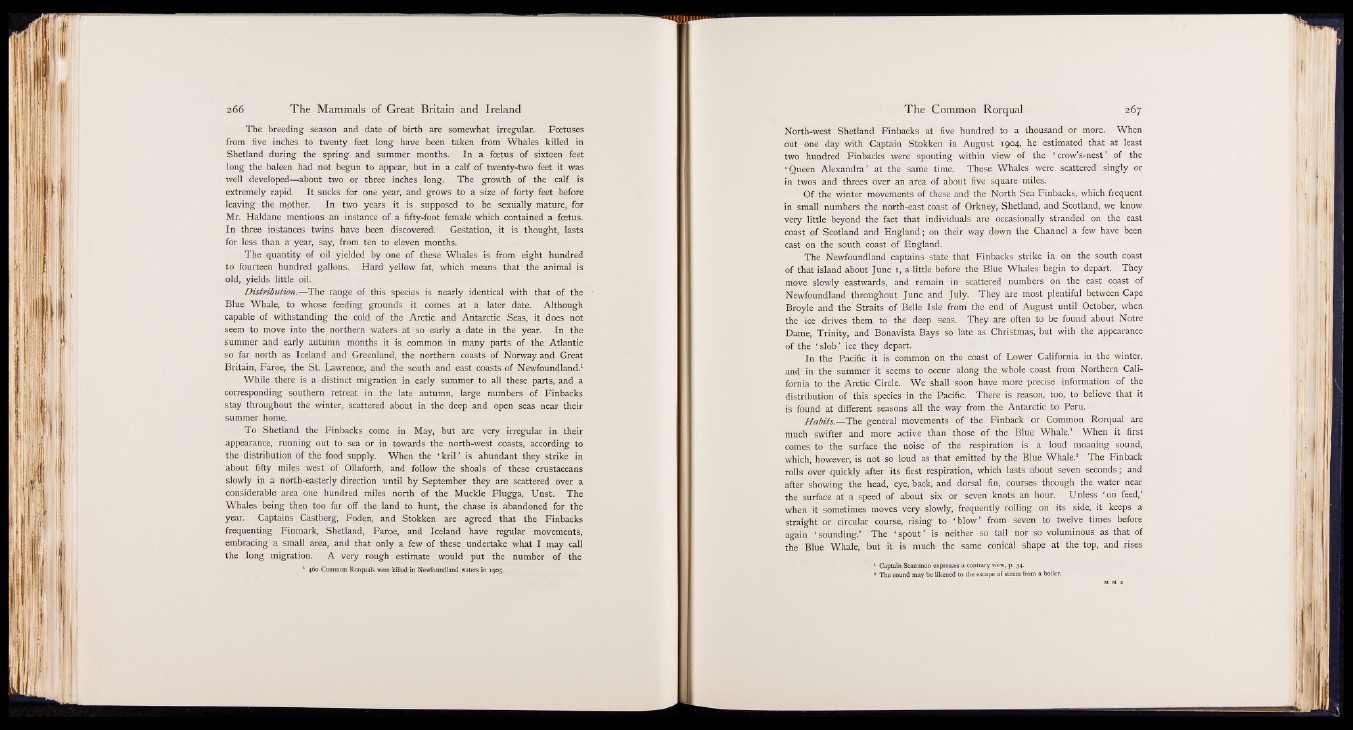
The breeding season and date of birth are somewhat irregular. Foetuses
from five inches to twenty feet long have been taken from Whales killed in
Shetland during the spring and summer months. In a foetus of sixteen feet
long the baleen had not begun to appear, but in a calf of twenty-two feet it was
well developed— about two or three inches long. The growth of the calf is
extremely rapid. It sucks for one year, and grows to a size of forty feet before
leaving the mpther. In two years it is supposed to be sexually mature, for
Mr. Haldane mentions an instance of a fifty-foot female which contained a foetus.
In three instances twins have been discovered. Gestation, it is thought, lasts
for less than a' year, say, from ten to eleven months.
The quantity of oil yielded by one of these Whales is from eight hundred
to fourteen hundred gallons. Hard yellow fat, which means that the animal is
old, yields little oil.
Distribution.— The range of this species is nearly identical with that of the
Blue Whale, to whose feeding grounds it comes at a later date. Although
capable of withstanding the bold of the Arctic and Antarctic Seas, it does not
seem to move into the northern waters at so early a date in the year. In the
summer and early autumn months it is common in many parts of the Atlantic
so far north as Iceland and Greenland, the northern coasts of Norway and Great
Britain, Faroe, the St. Lawrence, and the south and east coasts of Newfoundland.1
While there is a distinct migration in early summer to all these parts, and a
corresponding southern retreat in the late autumn, large numbers of Finbacks
stay throughout the winter, scattered about in the deep and open seas near their
summer home.
To Shetland the Finbacks come in May, but are very irregular in their
appearance, running out to sea or in towards the north-west coasts, according to
the distribution of the food supply. When the ‘ kril ’ is abundant they strike in
about fifty miles west of Ollaforth, and follow the shoals of these crustaceans
slowly in a north-easterly direction until by September they are scattered over a
considerable area one hundred miles north of the Muckle Flugga, Unst. The
Whales being then too far off the land to hunt, the chase is abandoned for the
year. Captains Castberg, Foden, and Stokken are agreed that the Finbacks
frequenting Finmark, Shetland, Faroe, and Iceland have regular movements,
embracing a small area, and that only a few of these undertake what I may call
the long migration. A very rough estimate would put the number of the
1 460 Common Rorquals were killed in Newfoundland waters in 1905.
North-west Shetland Finbacks at five hundred to a thousand or more. When
out one day with Captain Stokken in August 1904« he estimated that at least
two hundred Finbacks were spouting within view of the ‘ crow’s-nest’ of the
‘ Queen Alexandra’ at the same time. These Whales were scattered singly or
in twos and threes over an area of about five square miles.
Of the winter movements of these and the North Sea Finbacks, which frequent
in small numbers the north-east coast of Orkney, Shetland, and Scotland, we know
very little beyond the fact that individuals are occasionally stranded on the east
coast of Scotland and England; on their way down the Channel a few have been
cast on the south coast of England.
The Newfoundland captains state that Finbacks strike in on the south coast
of that island about June 1, a little before the Blue Whales begin to depart. They
move slowly eastwards, and remain in scattered numbers on the east coast of
Newfoundland throughout June and July. They are most plentiful between Cape
Broyle and the Straits of Belle Isle from the end of August until October, when
the ice drives them to the deep seas. They are often to be found about Notre
Dame, Trinity, and Bonavista Bays so late as Christmas, but with the appearance
of the ‘ slob’ ice they depart.
In the Pacific it is common on the coast of Lower California in the winter,
and in the summer it seems to occur along the whole coast from Northern California
to the Arctic Circle. We shall soon have more precise information of the
distribution of this species in the Pacific. There is reason, too, to believe that it
is found at different seasons all the way from the Antarctic to Peru.
Habits.— The general movements of the Finback or Common Rorqual are
much swifter and more active than those of the Blue Whale.1 When it first
comes to the surface the noise of the respiration is a loud moaning sound,
which, however, is not so loud as that emitted by the Blue Whale.2 The Finback
rolls over quickly after its first respiration, which lasts about seven seconds; and
after showing the head, eye, back, and dorsal fin, courses through the water near
the surface at a speed of about six or seven knots an hour. Unless ‘ on feed/
when it sometimes moves very slowly, frequently rolling on its side, it keeps a
straight or circular course, rising to ‘ blow ’ from seven to twelve times before
again ‘ sounding/ The ‘ spout ’ is neither so tall nor so voluminous as that of
the Blue Whale, but it is much the same conical shape at the top, and rises
1 Captain Scammon expresses a contrary view, p. 34.
* The sound may be likened to the escape of steam from a boiler.